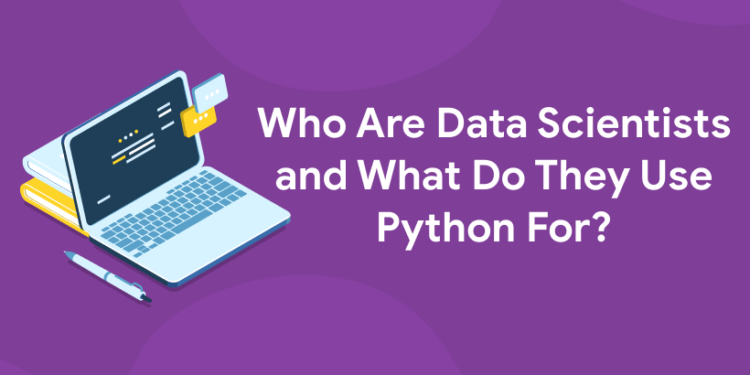Table of Contents
There are many professionals who use Python as part of their work, including data scientists, financial analysts, and natural language processors (NLP). These three groups all have one thing in common – they use Python to analyze data and make sense of the world around them. Let’s talk about what it means to be a data scientist, why you should consider learning Python for this profession, and how you can become an expert in these areas yourself! The term data scientist has become a buzzword in the tech industry over the past few years. There are numerous resources available on the Internet that discuss what data scientists do, so you might already be familiar with their job duties, but how many of you actually know who data scientists are?

A data scientist is an analytical person
Data scientists are analytical people who use their skills in math, statistics, and computer science to examine data and solve problems. Python is a versatile language that helps data scientists do their work more efficiently by automating repetitive tasks. Data scientists use Python for data wrangling, cleaning, and manipulation; for statistical analysis; for machine learning; and deep learning. In fact, the majority of respondents in our poll said they were using Python for some or all of these tasks. It’s clear from this survey that data scientists rely heavily on the power of Python as a programming language to perform their work. For one thing, it’s easy to see why they would be using it as an exploratory tool. The interactive shell allows them to test out code quickly without having to write a complete program first. And then once they’ve found something they like, they can save it into a file and run it again any time they want later–without having to retype everything again! Plus, Python comes with tons of libraries–a library is just a collection of pre-written code that can be used in your own programs–that make things even easier. You might already know about NumPy and SciPy, but did you know there are also libraries for controlling robots (rospy), reading XML files (lxml), parsing HTML (BeautifulSoup), scraping web pages (MechanicalSoup), or making games? All told, there are over 300 libraries available for general use at PyPI.
“Experience the power of our web development course with a free demo – enroll now!”
What do Data Scientists use Python for?
1: Which of the following data types is immutable in Python?
Data scientists use Python for a variety of tasks, including data wrangling, cleaning, analysis, and visualization. Python is a versatile language that allows data scientists to work with a variety of data types and sources. Python is also a popular language for building machine learning models. Data scientists use Python to build models that can make predictions about future events or trends. It’s easy to quickly iterate on different algorithms in order to find the one that best predicts the outcomes. One example of an organization using Python for predictive analytics is Apple Inc., which uses it as part of its new product release strategy. The company uses predictive analytics in order to predict demand so they know how many units they need from suppliers like Foxconn and Corning.
The company also uses predictive analytics for marketing purposes, by using it to predict what ad campaigns will be most effective at increasing sales revenue or brand engagement. Predictive analytics doesn’t just have benefits for companies – it has benefits for individual users as well! Facebook uses predictive analytics to tailor each user’s news feed so they see more of the posts they want to see. By predicting what posts each user wants to see, Facebook makes their experience more enjoyable and personalizes their social media interactions. Twitter also uses predictive analytics for similar reasons; if you follow someone who only tweets once every few days, Twitter will not show you those tweets until you start following them again. These examples demonstrate how important big data insights are in today’s world and why we need talented people like data scientists who can help us better understand our world through modeling and prediction!
🚀 Start Coding Today! Enroll Now with Easy EMI Options. 💳✨
Gain expertise in Django and open doors to lucrative opportunities in web development.
Start Learning With EMI Payment OptionsThe best paying Data Science job in 2018
Data scientists are in high demand due to the growing need for organizations to make data-driven decisions. Python is a versatile language that is popular among data scientists for its ease of use and robust libraries. Data scientists use Python for data wrangling, analysis, and visualization. They are also responsible for building machine learning models to make predictions. As a result, these professionals have to have strong coding skills and knowledge of programming languages like Python. These skills often translate into lucrative careers with the best paying job being found at $140,000. The next highest paying jobs were found at $126,000, which can vary depending on industry and experience level. Data scientists may be required to complete an online course on data science fundamentals before they can land a job. The average starting salary for someone with this certification was found to be around $84,000.
However, some employers do require four years of work experience in addition to the credential. Companies that typically hire data scientists include McKinsey & Company, Uber Technologies Inc., Apple Inc., and Google LLC. The most common degree requirement for a data scientist position is a bachelor’s degree in computer science or mathematics. Candidates with other degrees or no degree will likely need to go through additional training programs or gain more work experience to break into the field. Due to the demanding nature of this profession, many workers find themselves working overtime hours without compensation. Furthermore, career growth within data science positions is limited because there are few opportunities for promotions as most companies only hire entry-level workers. If you’re looking for one of the best-paid jobs in 2018 that don’t require a college degree, then consider pursuing data science.
from novice to pro python programming at entri app ! get free demo video !
Where are data science jobs
There are data science jobs in a variety of industries, including healthcare, finance, technology, and retail. Data scientists use Python for a variety of tasks, including data wrangling, machine learning, and deep learning. With the vast amount of data that is generated every day, data scientists are in high demand. If you’re interested in a career in data science, learning Python is a great place to start. The following table compares three popular programming languages with regard to ease of use, popularity, and applicability for data science. Python is arguably the most popular language among data scientists due to its versatility, which means it can be used for many different purposes in a data scientist’s workflow. Additionally, Python has been ranked as one of the top ten most valuable skills by Forbes. Java was once the go-to language for developers and programmers because it was so versatile; however, Java now seems outdated when compared to more modern languages like JavaScript or Python.
“Get hands-on with our python course – sign up for a free demo!”
As such, many people who may have had Java as their first language are moving on to learn other languages like JavaScript or Python. JavaScript has grown increasingly popular over the past few years, largely due to an increased focus on web development and the availability of open-source frameworks.
One advantage of JavaScript is that it’s supported by nearly all browsers, making it easier for web developers to create projects from scratch. A downside is that there isn’t an easy way to integrate backend workflows into your project since much of the server code needs to be written in another language (such as NodeJS).
🚀 Start Coding Today! Enroll Now with Easy EMI Options. 💳✨
Gain expertise in Django and open doors to lucrative opportunities in web development.
Start Learning With EMI Payment OptionsHow can I become a Data Scientist?
Data scientists are in high demand due to the vast amounts of data being generated every day. To become a data scientist, you need to have strong math and programming skills, as well as the ability to think critically and solve complex problems. Python is a popular programming language used by data scientists because it is easy to read and has many modules that can be used for data analysis. If you want to become a data scientist, start by learning Python and then begin exploring various data sets. As you learn more about the data science field, decide what your interests are (e.g., bioinformatics, finance) and find organizations or companies that may interest you. Once you’ve found an organization or company that interests you, search for open positions on their website or contact them directly.
Are you aspiring for a booming career in IT? If YES, then dive in |
||
Full Stack Developer Course |
Python Programming Course |
Data Science and Machine Learning Course |
Free resources to learn Python
Dataquest offers interactive in-browser courses that guide you through the basics of data analysis and introduce you to powerful Python tools like pandas, NumPy, and matplotlib. After completing these courses, you’ll be able to tackle some of the most common data science tasks. Best of all, every course is free. Once you’ve learned the basics of Python, you can move on to more specialized courses like machine learning or web development. But don’t feel like you need to spend months or years learning Python before you can start doing data science. With just a few weeks of study, you can be ready to start using Python for data science. There are also online communities where you can ask questions about your code and share your projects with other learners. If you’re looking for feedback on your ideas, sites like Kaggle provide opportunities to compete against others by finding solutions to real-world problems. The site’s interface lets you track your progress while working with datasets from Google Maps or social media sites like Twitter.
“Ready to take your python skills to the next level? Sign up for a free demo today!”
Data scientists and python
Data scientists are responsible for extracting meaning from data to help organizations make better decisions. They use their skills in statistics, programming, and machine learning to wrangle data, build models, and generate insights. As a result, Python is one of the most popular languages among data scientists. Python has numerous libraries that provide tools for everything from cleaning dirty datasets to creating interactive visualizations with matplotlib or seaborn. In fact, there’s an entire project dedicated solely to using python for data science called PySparkle! You can find all sorts of tutorials on how to do just about anything in data science, whether you’re looking for a refresher on the basics or want to dive into more advanced topics like time series forecasting. There’s also plenty of free courses online if you’re trying to learn something new and don’t have any formal training yet. We’ve rounded up some of our favorite places to get started so you can take your first steps as a data scientist today!
Related Articles
| Our Other Courses | ||
| MEP Course | Quantity Surveying Course | Montessori Teachers Training Course |
| Performance Marketing Course | Practical Accounting Course | Yoga Teachers Training Course |











